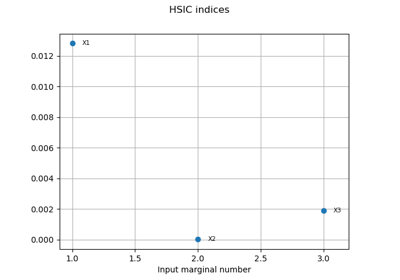HSICVStat¶
- class HSICVStat(*args)¶
Biased HSIC statistics.
See also
Notes
This a biased estimator for the computation of an HSIC index.
Methods
computeHSICIndex(CovMat1, CovMat2, weights)Compute the HSIC index between two samples.
computePValue(distribution, n, HSICObs, mHSIC)Compute the p-value of the statistic.
Accessor to the object's name.
getName()Accessor to the object's name.
hasName()Test if the object is named.
Indicate the compatibility with a conditional HSIC estimator.
setName(name)Accessor to the object's name.
- __init__(*args)¶
- computeHSICIndex(CovMat1, CovMat2, weights)¶
Compute the HSIC index between two samples.
- Parameters:
- covarianceMatrixX
CovarianceMatrix The xi-covariance model discretized over the input marginal sample xi.
- covarianceMatrixY
CovarianceMatrix The covariance model associated with the output sample, discretized over the last one.
- weights
PointorMatrix(deprecated) The weight argument used for the statistic.
- covarianceMatrixX
- Returns:
- hsicIndexthe HSIC index of the two
Sample.
- hsicIndexthe HSIC index of the two
- computePValue(distribution, n, HSICObs, mHSIC)¶
Compute the p-value of the statistic.
- getClassName()¶
Accessor to the object’s name.
- Returns:
- class_namestr
The object class name (object.__class__.__name__).
- getName()¶
Accessor to the object’s name.
- Returns:
- namestr
The name of the object.
- hasName()¶
Test if the object is named.
- Returns:
- hasNamebool
True if the name is not empty.
- isCompatibleWithConditionalAnalysis()¶
Indicate the compatibility with a conditional HSIC estimator.
- Returns:
- isCompatiblebool
Indicate the compatibility with a conditional HSIC estimator (true).
- setName(name)¶
Accessor to the object’s name.
- Parameters:
- namestr
The name of the object.
 OpenTURNS
OpenTURNS
